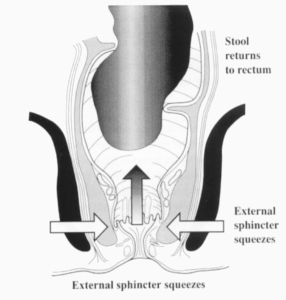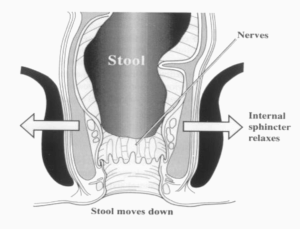People with faecal incontinence or leakage of faeces can be helped by undertaking special exercises to strengthen the sphincter muscles. With regular practice, sphincter exercises can help you to improve your bowel control. These exercises can build up and strengthen the muscles to help you hold both gas and stool in the back passage, when done correctly. Check with your healthcare professional to see if these exercises will help you.
Where are the Sphincter Muscles?
To locate your anal sphincter muscles, pretend that you are trying to hold in a bowel movement or prevent yourself from passing wind. You should now feel the muscles around your anus start to tighten.
You should sit, stand or lie in a comfortable position with your legs slightly apart. Now try and squeeze the muscles for as long as you can. Relax in between each squeeze. Try to hold for up to 10 seconds and do this up to 10 times. Next squeeze the muscles as hard as you can, then relax. Repeat this up to 10 times.
For a more detailed explanation on how to carry out the exercises, please read on.
Why is Anal Sphincter Function important?
The back passage, or anus, has two rings of muscle around it (see figures 1 and 2) which form the anal sphincter muscles – it’s these that can lose strength and function in relation to faecal incontinence.
The inner ring is the internal sphincter, an involuntary muscle which should be closed at all times, except when you are actually trying to open your bowels. This is normally automatic; you don’t have to think about doing it.
The outer ring of muscle is the external sphincter, which is a voluntary muscle which you can tighten up to close it more firmly if you have urgency or diarrhoea.


What are the anal sphincter muscles and how do they work?
Both muscles wrap right around the anus. When a stool comes into the rectum the internal sphincter relaxes and allows the stool to enter the top part of the anus. Very sensitive nerves in the anal canal can tell you if it’s gas or stool waiting to come out.
If it is stool, you squeeze your external sphincter to stop it from coming straight out.
This squeezing moves the stool back into the rectum, where it waits until you get to the toilet. Either or both of these sphincter muscles can become weak. This may be because of childbirth, constipation and straining or general wear and tear. Sometimes there is no obvious reason why.
If you have weak muscles and cannot squeeze enough to hang on, you will feel urgency and may leak gas, liquid or even solid stool (see figure 3 below).

How can anal sphincter exercises help?
Sphincter Exercises can strengthen the muscles around the anal canal so that they once again give support (see figure 4). This can improve your bowel control and improve or stop leakage of gas or stool. Like any other muscles in the body, the more you use and exercise them, the stronger the sphincter muscles will become.

How to to do anal sphincter exercises (detailed steps)
It is important to learn to do the exercises in the right way, and to check from time to time that you are still doing them correctly. Sit comfortably with your knees slightly apart. Now imagine that you are trying to stop yourself passing wind from the bowel. To do this you must squeeze the muscle around the back passage.
Try squeezing and lifting that muscle as tightly as you can. You should be able to feel the muscle move. Your buttocks, tummy and legs should not move much at all. You should be aware of the skin around the back passage tightening and being pulled up and away from your chair.
You should not need to hold your breath when you tighten the muscles.
Now imagine that the sphincter muscle is a lift. When you squeeze as tightly as you can your lift goes up to the 4th floor. But you cannot hold it there for very long, and it will not get you safely to the toilet as it will get tired very quickly.
So now squeeze more gently, take your lift only up to the 2nd floor. Feel how much longer you can hold it than at the maximum squeeze.
Practising Your Exercises
- Sit, stand or lie with your knees slightly apart. Tighten and pull up the sphincter muscles as tightly as you can. Hold for at least 5 seconds, then relax for at least 10 seconds.
Repeat at least 5 times. This will work on the strength of your muscles.
- Next, pull the muscles up to about half of their maximum squeeze. See how long you can hold this for. Then relax for at least 10 seconds.
Repeat at least 5 times to work on the endurance or staying power of your muscles.
- Pull up the muscles as quickly and tightly as you can and then relax and then pull up again, and see how many times you can do this before you get tired. Try for at least 5 quick pull-ups.
- Do these exercises at least 10 times every day: 5 times as hard as you can, 5 times as long as you can, and as many quick pull-ups as you can.
- As the muscles get stronger, you will find that you can hold for longer than 5 seconds, and that you can do more pull-ups each time without the muscle getting tired.
- It takes time for the exercises to make your muscles stronger. You may need to exercise regularly for several months before the muscles gain their full strength.
Tips to help you
- At first it is probably a good idea to set aside some time for these exercises and really concentrate on getting them right. But quite soon they should become easy to do wherever you are. Nobody needs to know what you are doing!
- Get into the habit of doing your exercises with things you do regularly; such as when you spend time on your phone, do routine activities around the house or watch television.
- If you are unsure that you are exercising the right muscle, put a finger on the anus as you squeeze to check. You should feel a gentle lift and squeeze if you are exercising the right muscle. Or look at the area in a mirror – you should see the anus pucker up as you squeeze it.
- Use your muscles when you need them – pull up the muscles if you feel urgency and that you are about to leak. But remember that you cannot hold your tightest squeeze for very long, so you are better to use a gentle squeeze that you can hold for longer. Your control will gradually improve.
- Watch your weight – extra weight puts extra strain on your muscles.
- Once you have regained control of your bowel, don’t forget your exercises. Continue to do them a few times each day to ensure that the problem does not come back.
Do your exercises regularly. Have faith in them. You should begin to see good results in a few weeks.





